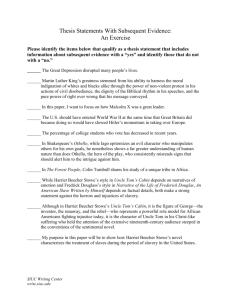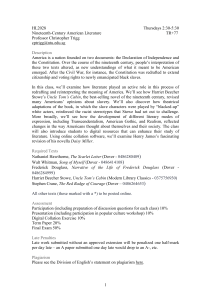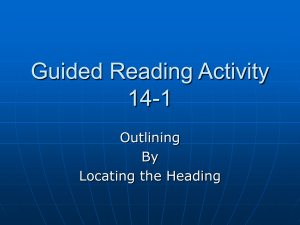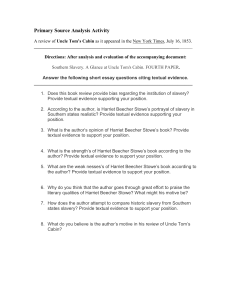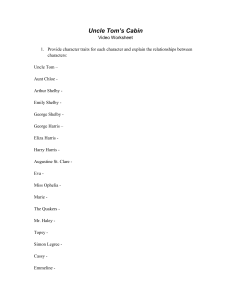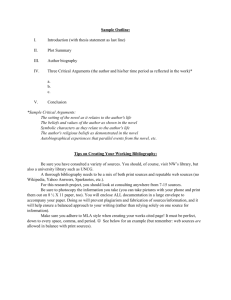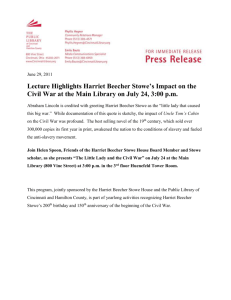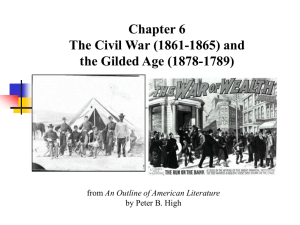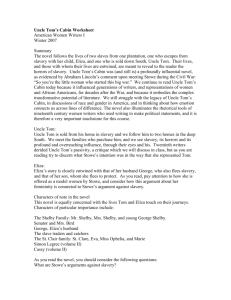UNCLE TOM'S CABIN
advertisement
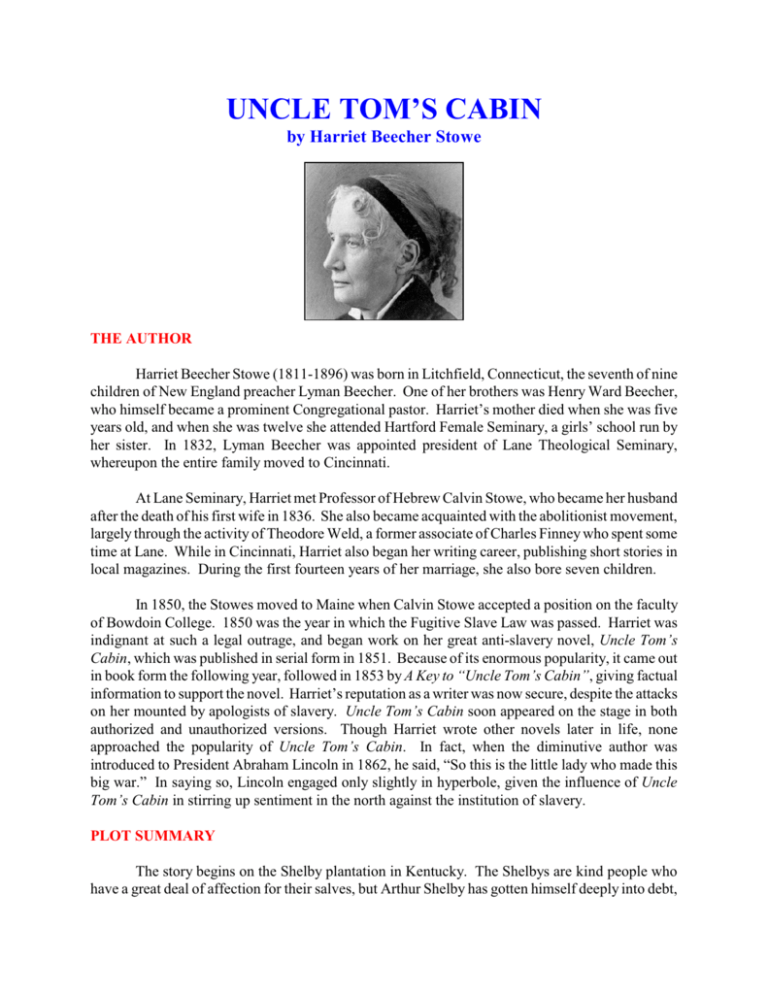
UNCLE TOM’S CABIN by Harriet Beecher Stowe THE AUTHOR Harriet Beecher Stowe (1811-1896) was born in Litchfield, Connecticut, the seventh of nine children of New England preacher Lyman Beecher. One of her brothers was Henry Ward Beecher, who himself became a prominent Congregational pastor. Harriet’s mother died when she was five years old, and when she was twelve she attended Hartford Female Seminary, a girls’ school run by her sister. In 1832, Lyman Beecher was appointed president of Lane Theological Seminary, whereupon the entire family moved to Cincinnati. At Lane Seminary, Harriet met Professor of Hebrew Calvin Stowe, who became her husband after the death of his first wife in 1836. She also became acquainted with the abolitionist movement, largely through the activity of Theodore Weld, a former associate of Charles Finney who spent some time at Lane. While in Cincinnati, Harriet also began her writing career, publishing short stories in local magazines. During the first fourteen years of her marriage, she also bore seven children. In 1850, the Stowes moved to Maine when Calvin Stowe accepted a position on the faculty of Bowdoin College. 1850 was the year in which the Fugitive Slave Law was passed. Harriet was indignant at such a legal outrage, and began work on her great anti-slavery novel, Uncle Tom’s Cabin, which was published in serial form in 1851. Because of its enormous popularity, it came out in book form the following year, followed in 1853 by A Key to “Uncle Tom’s Cabin”, giving factual information to support the novel. Harriet’s reputation as a writer was now secure, despite the attacks on her mounted by apologists of slavery. Uncle Tom’s Cabin soon appeared on the stage in both authorized and unauthorized versions. Though Harriet wrote other novels later in life, none approached the popularity of Uncle Tom’s Cabin. In fact, when the diminutive author was introduced to President Abraham Lincoln in 1862, he said, “So this is the little lady who made this big war.” In saying so, Lincoln engaged only slightly in hyperbole, given the influence of Uncle Tom’s Cabin in stirring up sentiment in the north against the institution of slavery. PLOT SUMMARY The story begins on the Shelby plantation in Kentucky. The Shelbys are kind people who have a great deal of affection for their salves, but Arthur Shelby has gotten himself deeply into debt, and is forced to sell two of his slaves to Mr. Haley, a rough slave trader. He decides to sell Tom, a trusted hand who runs his plantation for him, and Harry, a young boy who is the son of Emily Shelby’s maid Eliza. Emily strongly opposes the sale, but is able to do nothing to prevent it. When Eliza discovers what Shelby intends to do, she determines to run away with her son and try to reach Canada. Her husband George Harris, who is a slave on a neighboring plantation, is mistreated by his master and also runs away. Periodically the novel cuts away to follow their adventures. Eliza, pursued by slave-catcher Tom Loker and his gang, succeeds in escaping, and in a heroic feat crosses the Ohio River on the ice with her child. George escapes by disguising himself as a Spanish nobleman. The two are eventually reunited in a Quaker settlement in Ohio, and the Quakers help them make their escape into Canada, where they settle down for a time. Eventually, after gaining an education in France, George takes his family to the newly-formed colony of Liberia in West Africa. The focus of the novel follows Tom in his travels. After being separated from his wife and children, he is sent to New Orleans to be sold. While traveling down the Mississippi, he meets Augustine St. Clare and his young daughter Evangeline (known as Eva). Eva befriends Tom, and she convinces her father to buy him, which he gladly does after Tom saves Eva from drowning. On the St. Clare plantation in Louisiana, Tom serves as a carriage driver and a personal attendant to little Eva, and soon is given the task of supervising the other slaves, which he does with great integrity. St. Clare is a careless owner, exercising no discipline over his slaves, and being constantly subject to the nagging of his self-centered, malcontent hypochondriac of a wife, Marie. His cousin, Ophelia, runs the estate for him, and is gradually purged of her racist attitudes by the example of Tom and Eva. The final transition in her life occurs when Augustine buys a young slave girl, Topsy, who was abused by her former owners, for her to raise. She grows to love Topsy, and is changed by her in the process. Meanwhile, Eva grows increasingly weak, and it becomes evident that she has contracted a case of tuberculosis from which she will never recover. Her death deeply affects everyone who knew her, especially Topsy, who determines to be a good Christian because of Eva’s example, and her father, who decides to set Tom free. Before the legal papers can be completed, however, Augustine is stabbed to death trying to break up a tavern brawl. On his deathbed, he converts to Christianity, a religion that he had previously shunned despite Eva and Tom’s endeavors. With St. Clare’s death, Marie gains control of the property. She decides to sell everything and return to her parents’ plantation. Ophelia returns to Vermont in disgust, taking Topsy with her, but the other slaves are sold, including Tom, since Marie refused to honor her husband’s last wish. Tom is sold to the vicious planter Simon Legree, who takes him to a farm in the middle of the swamp and determines to break him to his will or kill him in the process. Tom maintains his integrity when he refuses to flog other slaves, which only angers Legree further. Tom is beaten severely by Legree’s two black overseers, Sambo and Quimbo, who share their master’s cruelty as a way of ingratiating themselves to him. Tom is nursed back to health by Cassy, a slave on the plantation who had been the mistress of Simon Legree, but who had recently been replaced by Emmaline, a fifteen-year-old Christian slave girl purchased at the same time as Tom. Cassy tells Tom her story, including the tale of being separated from her daughter when the girl was little more than an infant, then brutalized for years by Legree. Because she no longer fears Legree, she has a strange power over him, however. When Emmaline confides in Cassy, the two decide to escape in order to preserve Emmaline from the fate Cassy had endured. They tell Tom of their plans, and when they escape, Tom is questioned by Legree, who suspects he had a part in the plan. Tom admits that he knows where the women went, but he refuses to divulge their location. Sambo and Quimbo then administer a fatal beating to Tom, which he endures with Christian charity, forgiving his tormentors even as they flog the life out of him. In the end, they are converted, though their master is not. A few days later, George Shelby, the son of Tom’s original master, arrives to buy him back as his father had promised to do. Finding that he is too late, he thrashes Legree and mourns over the grave of his beloved Uncle Tom. After returning to Kentucky, he frees all the salves on the plantation he has now inherited from his father and vows to do everything he can to fight the evil institution. Meanwhile, Cassy and Emmaline, on a boat heading for the North, meet George Harris’ sister. As they exchange stories, it becomes increasingly obvious that Cassy’s long-lost daughter is none other than Eliza, George Harris’ wife, who had fled with her young son to Canada years before. Cassy and Emmaline seek them out, and the family is joyfully reunited. MAJOR CHARACTERS • Uncle Tom - The protagonist of the story, Uncle Tom is a pious slave who runs the Shelby plantation. He is first sold to the slave-trader Haley to pay a debt; Haley then sells him to Augustine St. Clare, who treats him well. After St. Clare dies, he is sold to the brutal Simon Legree, who hates him for his piety and eventually has him beaten to death for refusing to reveal the whereabouts of escaped slaves Cassy and Emmaline. • Aunt Chloe - Tom’s wife and the mother of his three children, from whom he is separated when he is sold by the Shelbys. • Arthur Shelby - Tom’s original owner, he sells Tom to pay off a debt he owes to Haley. Despite his good heart, he sees no alternative to breaking up the families of his slaves when his finances require it. He leaves the religion in the family to his wife. • Emily Shelby - Arthur’s wife and a devout Christian, she hates slavery and tries to prevent her husband from selling Tom and Harry. • George Shelby - Arthur and Emily’s son, he loves Tom and promises to rescue him after his father sells him. When he finally is able to do so, it is too late, but he returns home and frees all the slaves on his plantation after his father’s death, and vows to fight slavery in any way he can. • Eliza Harris - Emily Shelby’s maid, she runs away with her son Harry when she discovers that Shelby intends to sell him. She heroically escapes by crossing the Ohio River on ice floes while being pursued by Tom Loker. • George Harris - Eliza’s husband, a slave on another plantation. George is a talented and hard-working man who invents an industrial process that makes a lot of money for his owner, who nonetheless treats him harshly out of jealousy. He runs away, disguised as a Spanish gentleman, and is reunited with Eliza and Harry. The three then flee to Canada with the help of some kindly Quakers. • Haley - A slave trader who buys Tom and Harry; he sends Tom Loker and his gang after Eliza and Harry when they escape, then takes Tom down the Mississippi River and sells him to St. Clare in New Orleans. • Tom Loker - A slave-catcher hired by Haley to retrieve Harry, he figures to capture Eliza as well and sell her at a profit. He fails when George shoots him in the side. He is nursed back to health by Quakers, and he then repents and helps the Harrises make their escape. • Rachel Halliday - A Quaker matriarch who, with her husband and friends, shelters Eliza and Harry and helps them on their journey to Canada. • Senator Bird - An Ohio state senator who, despite his personal dislike for slavery and willingness to protect Eliza and Harry when they show up on his doorstep, still votes for the Fugitive Slave Law, convinced that one person can do nothing to change the system. • Mrs. Bird - The Senator’s wife, a Christian woman who tries to get the Senator to live up to his convictions. • Augustine St. Clare - A careless and lazy planter who buys Tom after the slave rescues his daughter Eva from drowning. He exercises no discipline on his plantation, and ultimately leaves all of his business in Tom’s hands. After he dies trying to break up a tavern brawl, Tom and his other slaves are sold at auction, and Tom winds up in the hands of Simon Legree. • Marie St. Clare - Augustine’s wife, she is from an aristocratic family and is convinced she has married beneath her place in society. She is a self-centered, whining hypochondriac who thinks of nothing but her own petty inconveniences, which she views as great sufferings. When Augustine is killed, she quickly auctions Tom off despite her husband’s promise to give him his freedom. • Evangeline St. Clare (Little Eva) - A pure Christian child who improves everyone she touches except her mother, she befriends Tom after he rescues her, and he then becomes her constant companion. She is an outspoken opponent of slavery, and her death from tuberculosis is the great tragedy of the story. She, along with Tom, serves as a Christ-figure in the novel. • Ophelia St. Clare - Augustine’s cousin, she comes down from Vermont to run the St. Clare household, since Marie is completely incapable of doing so. She opposes slavery, but at the same time is deeply prejudiced against blacks. The influences of Tom, Eva, and Topsy change her attitude, however, and she takes Topsy back to Vermont with her and gives her her freedom at the end of the book. • Topsy - A young slave girl bought by Augustine for Ophelia to raise, she was abused by her former masters and is at first wild and uncontrollable. She changes, however, as Eva shows confidence in her, and finally becomes a Christian and wins the heart of Ophelia. She grows up to be a missionary to Africa. • Simon Legree - A brutal Louisiana planter who buys Tom at the slave auction after St. Clare’s death, he is determined to break him at all costs. When Tom refuses to flog a fellow slave, Legree has him beaten. Later, when Tom refuses to divulge the whereabouts of the escaped Cassy and Emmaline, Legree has him flogged to death. • Cassy - Legree’s slave mistress and Eliza’s mother, from whom she was separated as a young child. She plans a clever escape for herself and Emmaline. • Emmaline - A godly young slave purchased by Legree at the same time he buys time, he intends to make her his mistress in place of Cassy. When she begs Cassy for help, the two make their escape. • Sambo and Quimbo - Legree’s vicious slave overseers, they beat Tom to death, but are converted by his consistent testimony and his forgiveness of them before he dies. NOTABLE QUOTATIONS “But it was in prayer that he especially excelled. Nothing could exceed the touching simplicity, the child-like earnestness, of his prayer, enriched with the language of scripture, which seemed so entirely to have wrought itself into his being, as to have become a part of himself, and to drop from his lips unconsciously.” (p.38) “O, Mr. Shelby, I have tried - tried most faithfully, as a Christian woman should - to do my duty to these poor, simple, dependent creatures. I have cared for them, instructed them, watched over them, and known all their cares and joys, for years; and how can I ever hold up my head again among them, if, for the sake of a little paltry gain, we sell such a faithful, excellent, confiding creature as poor Tom, and tear from him in a moment all we have taught him to love and value? I have taught them the duties of the family, of parent and child, and husband and wife; and how can I bear to have this open acknowledgment that we care for no tie, no duty, no relation, however sacred, compared with money? I have talked with Eliza about her boy - her duty to him as a Christian mother, to watch over him, pray for him, and bring him up in a Christian way; and now what can I say, if you tear him away, and sell him, soul and body, to a profane, unprincipled man, just to save a little money? I have told her that one soul is worth more than all the money in the world; and how will she believe me when she sees us turn round and sell her child? - sell him, perhaps, to certain ruin of body and soul!” (Emily Shelby, p.42) “Obeying God never brings on public evils. I know it can’t. It’s always safest, all round, to do as He bids us.” (Mary Bird, p.99) “‘Don’t’ quote the Bible at me that way, Mr. Wilson,’ said George, with a flashing eye, ‘don’t! for my wife is a Christian, and I mean to be, if ever I get to where I can; but to quote Bible to a fellow in my circumstances, is enough to make him give it up altogether. I appeal to God Almighty; - I’m willing to go with the case to Him, and ask Him if I do wrong to seek my freedom.’” (George Harris, p.136) “But who, sir, makes the trader? Who is most to blame? The enlightened, cultivated, intelligent man, who supports the system of which the trader is the inevitable result, or the poor trader himself? You make the public sentiment that calls for his trade, that debauches and depraves him, till he feels no shame in it; and in what are you better than he? Are you educated and he ignorant, you high and he low, you refined and he coarse, you talented and he simple? In the day of future Judgment, these very considerations may make it more tolerable for him than for you. In concluding these little incidents of lawful trade, we must beg the world not to think that American legislators are entirely destitute of humanity, as might, perhaps, be unfairly inferred from the great efforts made in our national body to protect and perpetuate this species of traffic. Who does not know how our great men are outdoing themselves, in declaiming against foreign slave-trade. There are a perfect host of Clarksons and Wilberforces risen up among us on that subject, most edifying to hear and behold. Trading Negroes from Africa, dear reader, is so horrid! It is not to be thought of! But trading them from Kentucky, - that’s quite another thing!” (p.164-165) “This, indeed, was a home, - home, - a word that George had never yet known a meaning for; and a belief in God, and trust in His providence, began to encircle his heart, as, with a golden cloud of protection and confidence, dark, misanthropic, pining, atheistic doubts, and fierce despair, melted away before the light of a living Gospel, breathed in living faces, preached by a thousand unconscious acts of love and good will, which, like the cup of cold water given in the name of a disciples, shall never lose their reward.” (p.174-175) “Not that there is a particle of virtue in our not having it; but custom with us does what Christianity ought to do, - obliterates the feeling of personal prejudice. I have often noticed, in my travels north, how much stronger this was with you than with us. You loathe them as you would a snake or a toad, yet you are indignant at their wrongs. You wold not have them abused; but you don’t want to have anything to do with them yourselves. You would send them to Africa, out of your sight an smell, and then send a missionary or two to do up all the self-denial of elevating them compendiously. Isn’t that it?” (Augustine St. Clare, p.220-221) “Trusted to an unlimited extent by a careless master, who handed him a bill without looking at it, and pocketed the change without counting it, Tom had every facility and temptation to dishonesty; and nothing but an impregnable simplicity of nature, strengthened by Christian faith, could have kept him from it. But, to that nature, the very unbounded trust reposed in him was bond and seal for the most scrupulous accuracy.” (p.251) “When you see that deep, spiritual light in the eye, - when the little soul reveals itself in words sweeter and wiser than the ordinary words of children, - hope not to retain that child, for the seal of heaven is on it, and the light of immortality looks out from its eyes.” (p.323) “Felt Him in my soul, Mas’r, - feels Him now! O, Mas’r, when I was sold away from my old woman and the chil’en, I was jest a’most broke up. I felt as if there warn’t nothin’ left; and then the good Lord, he stood by me, and he says ‘Fear not, Tom’; and he brings light and joy into a poor feller’s soul, - makes all peace; and I’s so happy, and loves everybody, and feels willin’ jest to be the Lord’s, and have the Lord’s will be done, and be put jest where the Lord wants to put me. I know it couldn’t come from me, cause I’s a poor, complainin’ cretur; it comes from the Lord; and I know He’s willin’ to do for Mas’r.” (Uncle Tom, p.372) “We does for the Lord when we does for his critturs.” (Uncle Tom, p.377) “Mas’r, if you was sick, or in trouble, or dying, and I could save ye, I’d give ye my heart’s blood; and if taking every drop of blood in this poor old body would save your precious soul, I’d give ‘em freely, as the Lord gave his for me. O, Mas’r! don’t bring this great sin on your soul! It will hurt you more than ‘twill me! Do the worst you can, my troubles’ll be over soon; but, if ye don’t repent, yours won’t never end!” (Uncle Tom, p.508) “It was on his grave, my friends, that I resolved, before God, that I would never own another slave, while it was possible to free him; that nobody, through me, should ever run the risk of being parted from home and friends, and dying on a lonely plantation, as he died. So, when you rejoice in your freedom, think that you owe it to that good old soul, and pay it back in kindness to his wife and children. Think of your freedom, every time you see Uncle Tom’s Cabin; and let it be a memorial to put you all in mind to follow in his steps, and be as honest and faithful and Christian as he was.” (George Shelby, p.540) ESSAY QUESTIONS Discuss the following in a five-paragraph essay: 1. Harriet Beecher Stowe was not only an abolitionist, she was also a feminist. Discuss the view of women presented in Harriet Beecher Stowe’s Uncle Tom’s Cabin. What indications do you find that she portrayed women with a measure of equality not commonly accepted in the middle of the nineteenth century? 2. Critics of Harriet Beecher Stowe’s Uncle Tom’s Cabin complained that it presented an unrealistic picture of American slavery. In particular, they noted that almost every black character in the book is noble, and that even vicious blacks such as Sambo and Quimbo “ultimately go to heaven.” Is this a fair criticism? Do you consider the book unbalanced? Why or why not? Support your arguments with specifics from the novel. 3. Harriet Beecher Stowe’s Uncle Tom’s Cabin is unquestionably a Christian book, yet many critics in her own day complained that it was irreligious because of the extent to which it criticized the organized church. Do you think that these critics had a point? In your opinion, does the book do more to advance the church or to undermine it? Support your conclusion with specific evidence from the novel. 4. Harriet Beecher Stowe’s Uncle Tom’s Cabin does much to reveal the arguments tearing the United States apart in the decade prior to the Civil War. Stowe incorporates into her novel arguments on both sides of the slavery issue. In particular, she works into her story arguments used by Christians on both sides. Choose three biblical arguments from the novel, either for or against slavery, and evaluate them. Based on the points made in the novel, which side made the stronger case biblically? Why do you think so? 5. If one were to choose a heroine in Harriet Beecher Stowe’s Uncle Tom’s Cabin, it would undoubtedly be Little Eva. In your opinion, is she a realistic character? Why or why not? Does the perfection with which she is portrayed strengthen or weaken the points Stowe is trying to make through her character? 6. In Harriet Beecher Stowe’s Uncle Tom’s Cabin, the author emphasizes the importance of family. The greatest tragedy of the slave system, according to Stowe, is the extent to which it tears apart family units. In our own day, some have argued that the effects of this aspect of slavery have lingered to the present day in the observable weaknesses of the family structure in the black community (much higher rates of children born out of wedlock, single parenting, etc., than may be found in the general population). Is this a fair assessment? Is it realistic to argue that the black population of the country continues to suffer the consequences of the depredations of slavery almost a century and a half after the institution was terminated? 7. Despite the fact that Harriet Beecher Stowe’s Uncle Tom’s Cabin was one of the greatest single forces for the abolition of slavery in the United States, the author was a product of her times - so much so that some today argue that she wrote a racist novel. Do you agree or disagree? What components of the novel might be brought forward to support the charge of racism? In your opinion, should such a charge be diminished by the overall impact of the work in support of equal rights for blacks? Why or why not? 8. Harriet Beecher Stowe’s Uncle Tom’s Cabin in many ways reflects the impact of the Second Great Awakening on the American scene. Stowe was influenced by revival preachers such as her father Lyman Beecher, Charles G. Finney, and Theodore Weld. On a larger scale, the novel pictures the impact of Methodism, particularly in the South. Discuss the influence of the Methodist Church among the slave population, supporting your conclusions with specifics from the novel. 9. Harriet Beecher Stowe’s Uncle Tom’s Cabin contains two Christ-figures - Uncle Tom and Little Eva. Choose one of the two and discuss the ways in which the character represents the person of Christ in the story. 10. In Harriet Beecher Stowe’s Uncle Tom’s Cabin, Uncle Tom is pictured as a martyr at the end of the book. Compare and contrast the character of Uncle Tom with what you know about some of the martyrs during the Roman persecutions in the first three centuries of the Christian church. How are they alike? How are they different? Be sure to support your argument with specifics from the book and from your knowledge of church history. 11. In your study of rhetoric, you learned about logical appeals, ethical appeals, and emotional appeals. Choose an example of each kind of appeal from Harriet Beecher Stowe’s Uncle Tom’s Cabin, demonstrate how the appeal fits the type to which you assign it, and discuss the extent to which the appeal is effective. 12. Uncle Tom, the protagonist of Harriet Beecher Stowe’s Uncle Tom’s Cabin, is pictured as a hero and martyr, and was considered by the author to be a sterling example of Christian manhood. Today, however, his name is used as an insult directed toward blacks who are willing to submit to injustice rather than fight it. Is such a characterization unfair? Do you believe that Uncle Tom shows shameful weakness or Christlike meekness? Evaluate his response to injustice in the light of Scripture. 13. Uncle Tom, the protagonist of Harriet Beecher Stowe’s Uncle Tom’s Cabin, is pictured as a hero and martyr, and was considered by the author to be a sterling example of Christian manhood. Today, however, his name is used as an insult directed toward blacks who are willing to submit to injustice rather than fight it. What does the change in the way Uncle Tom is viewed over a period of 150 years indicate about changes that have occurred in American society? Do you believe these changes are for the better or for the worse? Support your argument with specific details from the novel. 14. In Harriet Beecher Stowe’s Uncle Tom’s Cabin, most of the characters remain consistent throughout the story, changing little from the way they are initially portrayed. There are a few exceptions, however. Which character do you believe undergoes the most significant transformation in the course of the novel? Why do your think so? Support your arguments with details from the story. 15. A foil is a character who, through contrast, brings out important characteristics in another character. Harriet Beecher Stowe’s Uncle Tom’s Cabin contains several sets of foils - Uncle Tom and Simon Legree, Augustine St. Clare and his brother Alfred, and Emily Shelby and Marie St. Clare, among others. Choose one set of foils and discuss ways in which the contrasts between the two help to establish important aspects of their characters and transmit key themes of the novel. 16. In Harriet Beecher Stowe’s Uncle Tom’s Cabin, what does the author believe is the one thing most essential for ending the evils of slavery in the United States? Do you think her attitude is a realistic one? Why or why not? Support your argument with details from the novel. 17. Harriet Beecher Stowe’s Uncle Tom’s Cabin is unquestionably intended as a piece of abolitionist propaganda. To whom was the work primarily directed - people in the North or those in the South? Why do you think so? Why would it have been less effective when read by those of the other region? Support your conclusion with specifics from the novel. 18. For much of the story, Harriet Beecher Stowe’s Uncle Tom’s Cabin pictures slavery in almost-ideal settings. Both the Shelbys and the St. Clares treat their slaves well. Yet the evils of the slave system are just as visible in these settings as they are at the end of the book on the plantation of the brutal Simon Legree. In what sense are Stowe’s arguments against slavery more powerful when they are made in comparatively mild settings? Support your arguments with details from the text. 19. Contrary to the beliefs of many people in her day, Harriet Beecher Stowe insisted that the practice of slavery and the principles of Christianity stood in unresolvable conflict with one another. In fact, in Uncle Tom’s Cabin, the more Christian a character is, the more he or she opposes slavery. Use details from the story to illustrate Stowe’s conviction. 20. Harriet Beecher Stowe’s Uncle Tom’s Cabin contains many female characters who are morally superior to the men around them. Stowe thus presents an argument to the effect that women can be instruments of social change, even when they are unable to vote, by influencing their husbands and sons. How does the early feminism of Harriet Beecher Stowe differ from the feminism of our own day? Evaluate her view of women in the light of the teachings of Scripture. 21. Discuss the role of divine providence in Harriet Beecher Stowe’s Uncle Tom’s Cabin. At several points in the novel, God intervenes on behalf of His children. How do these acts of divine intervention help to communicate the abolitionist message of the novel? Be specific. 22. Compare and contrast the three men who own Uncle Tom in Harriet Beecher Stowe’s Uncle Tom’s Cabin. How are Shelby, St. Clare, and Legree the same? How are they different? How do these similarities and differences contribute to the major themes of the narrative? 23. Because Harriet Beecher Stowe’s Uncle Tom’s Cabin is a novel of social changes, many of the characters are really caricatures - stock figures that show little depth or development over the course of the story. In your opinion, would the social message of the novel have been conveyed more or less effectively had the characters been portrayed in a more realistic fashion? Support your argument with specifics from the novel. 24. Harriet Beecher Stowe’s Uncle Tom’s Cabin was written the year after the passage of the Fugitive Slave Law, which required anyone in the United States, whether in the North or the South, to turn in runaway slaves. Stowe was outraged by this immoral law, and throughout the novel she contrasts one’s allegiance to the law of God with one’s duty to the state. Evaluate the view of civil disobedience found in the novel from the standpoint of Scripture. Does the Bible require the violation of unjust laws like the Fugitive Slave Law? Illustrate your answer with specific incidents and quotations from the book. 25. Harriet Beecher Stowe’s Uncle Tom’s Cabin contains numerous scenes of religious conversions. Choose one of these scenes and discuss the view of true Christianity communicated by the author. Does she understand the real nature of conversion? Why or why not? Support your answer with evidence from Scripture as well as the novel. 26. Some commentators argue that Harriet Beecher Stowe’s Uncle Tom’s Cabin was directed primarily to female readers in the North. What evidence can you find in the novel to support this assertion? Be sure to discuss plot structure, characterizations, and writing style in support of your arguments. 27. In the early years of the Civil Rights movement in the nineteen-fifties, civil rights leaders often chose the path of passive resistance depicted in Harriet Beecher Stowe’s Uncle Tom’s Cabin. Like Tom, they knelt and prayed while they were attacked by their enemies. Later, however, black militants ridiculed such behavior, insisting that blacks must fight for their rights. Which approach do you believe to be more biblical? more effective? Support your arguments with evidence from the novel and from Scripture. 28. With regard to Harriet Beecher Stowe’s Uncle Tom’s Cabin, Charles Stowe, the author’s son, argued that his mother “no more thought of style or literary excellence than the mother who rushes into the street and cries for help to save her children from a burning house.” What evidence do you find in the novel that it represents an outburst of fervent emotion more than a construct of literary artifice? Use specifics to support your case. 29. Motherhood is an important theme in Harriet Beecher Stowe’s Uncle Tom’s Cabin. Choose two mothers in the story, a good one and a bad one, and discuss how the contrasts between the two help the author to communicate the lessons she wishes to get across to her readers. 30. When Abraham Lincoln was introduced to Harriet Beecher Stowe in 1862, he said, “So this is the little lady who made this big war.” He was not exaggerating - two million copies of the novel were sold in the first two years after its publication in 1851. Discuss the characteristics of Uncle Tom’s Cabin that would have caused Lincoln to have described its author in these terms. How could a work of fiction have played a major role in causing the Civil War? Use specifics from the novel to support your argument. 31. In the days of slavery prior to the Civil War, Negro spirituals spoke of heavenly themes, but often were encoded with earthly meanings. For example, “crossing the river” spoke of death and entrance into heaven, but it also spoke of escape from the South to freedom in the North. How does this double symbolism appear in Harriet Beecher Stowe’s Uncle Tom’s Cabin. Discuss how she uses the symbol of “crossing the river” to advance the key themes of the novel. 32. Compare and contrast Alan Paton’s Cry, the Beloved Country with Harriet Beecher Stowe’s Uncle Tom’s Cabin. Which, in your opinion, is the more effective indictment of racial prejudice? Why do your think so? Support your argument with specifics from the two novels. 33. Compare and contrast George Eliot’s Daniel Deronda and Harriet Beecher Stowe’s Uncle Tom’s Cabin. Give special attention to the power of the story to overcome prejudice. Which novel is more effective as a critique of the prejudice that filled the society addressed by each author? Support your conclusion with details from both stories. 34. Mark Twain considered his Huckleberry Finn to be a light-hearted corrective to Harriet Beecher Stowe’s Uncle Tom’s Cabin, which he thought too heavy-handed and melodramatic. Compare and contrast the two as critiques of slavery. Which is the more effective? Why do you think so? Be sure to use specific quotations and incidents from the two novels in developing your answer. 35. Compare Harper Lee’s To Kill A Mockingbird and Harriet Beecher Stowe’s Uncle Tom’s Cabin as catalysts for social change. To what extent did these works of fiction serve as apologias for the Civil Rights Movement and abolitionism, respectively? What characteristics of fiction enable it to serve as a powerful instrument of social change? Of the two, which do you think is the more powerful? Support your conclusion with details from both stories. 36. Compare Harper Lee’s To Kill A Mockingbird and Harriet Beecher Stowe’s Uncle Tom’s Cabin in their portrayals of black society. Even though the two were separated by more than a hundred years, what do they have in common in their ways of presenting blacks? How are these portrayals central to the messages the two novels are seeking to communicate? 37. Compare Harper Lee’s To Kill A Mockingbird and Harriet Beecher Stowe’s Uncle Tom’s Cabin in their treatments of Christianity. Both clearly seek to promote “Christian” values. Are those values the same? Why or why not? Discuss the aspects of Christianity that were of greatest concern to the authors of the two books, and evaluate the extent to which they present Christianity in a way that is faithful to Scripture. 38. Some critics have suggested that John Bunyan’s Pilgrim’s Progress served as the foundation for Harriet Beecher Stowe’s Uncle Tom’s Cabin, with Tom traveling from home to heaven and facing trials along the way much as Christian did in Bunyan’s allegory. Cite evidence from both books to support the assertion. Be sure to include details, not just vague generalities. 39. Victor Hugo’s Les Miserables and Harriet Beecher Stowe’s Uncle Tom’s Cabin both portray the legal oppression of the poor in an unjust society. Compare and contrast the treatments of the problem in the two books, giving special attention to the ways in which the protagonists are portrayed. Both authors intend their protagonists to be Christ-figures. Do they fulfill this role in the same ways? What are the most important differences between the two? Which author has a more biblical picture of who Christ was and what He came to do?
